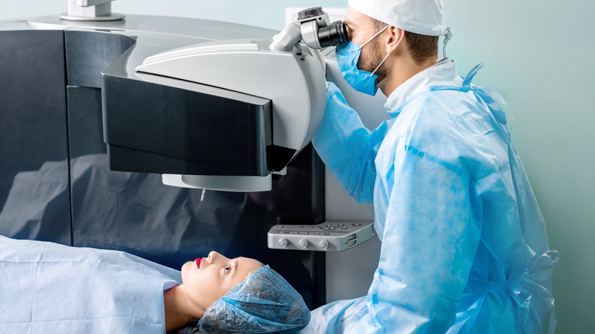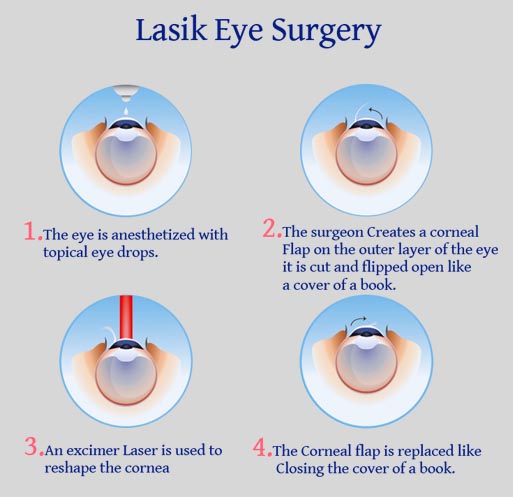Lasik Treatment
Spectacles or connections are not the first choice for everyone, and that’s understandable.However, your eye croaker may suggest ray- supported in-situ keratomileusis (LASIK) surgery, If you want to have clearer vision without the need for corrective lenses.
On the other hand, LASIK is not suitable for absolutely everyone. While it can help cases protest their reliance on spectacles or connections, some eye conditions ca n’t be fixed by surgically reshaping your cornea. We ’ve put together many points to consider if you ’re wondering about LASIK
Which Refractive Eye Can be Helped by LASIK?
This common type of refractive surgery eliminates the need for contact lenses or spectacles. People with moderate degrees of Myopia frequently qualify for this procedure.
How LASIK Works
Ray eye surgery has been around since 1987. LASIK is a popular surgery.To illustrate the difference, not all ray eye surgery is LASIK, but all LASIK is ray eye surgery.
The crucial advance that made LASIK the preferred methodology lies in the energy produced. The ray uses hyperactive-focused ultraviolet light, which vaporizes targeted cells, but causes no damage to immediate areas. For this reason, it’s called a “ cool ray.” It modifies the cornea to correct the refractive error.
What to Anticipate from LASIK Surgery
Clear Vision from Day 2 and as explained by your eye doctor.
Who Can’t benefit from LASIK?
While your eye doctor is the still the person to make the call, some factors make ray eye surgeries advisable. However, you might not be a eligible for LASIK
If you fall into the following orders.
●Under 18 years old
●Frequent changes in refractive error
●Extreme diplopia, presbyopia, or presbyopia
●Severe dry eye
●Cornea surface irregularities
●Cornea scrapes or complaint
●Keratoconus (cone- shaped cornea)
●Advanced glaucoma
●A cataract affecting vision
●A history of having certain eye infections
●Diabetes that isn’t controlled well
●Pregnant or nursing women

Before Surgery
Previous to LASIK, your eye doctor will perform a comprehensive eye test. The discussion includes checking vision, signs of infection, dry eyes, inflammation, high eye pressure, and large eye pupils. Pre-existing conditions like dry eye can occasionally worsen, so your eye doctor pays special attention to how LASIK might affect the health of your eyes.
Doctors at Rotary Eye will also measure each cornea, taking note of their figure, shape, irregularities, and consistency. Part of this discussion determines how high your refractive error is and whether LASIK can correct your vision or not.
During Surgery
After consulting with our eye doctor, we can relate you to an inpatient surgery center. Your eye surgeon uses a ray to reshape your cornea. LASIK procedure goes like this
●You ’ll get some topical anesthetic eye drops.
●Your surgeon will fix your eyelids in place to keep you from blinking.
●They ’ll also apply a suction ring on your eye to keep your eye from turning down. You ’ll feel slight pressure from the ring.
●At this point, your vision will subside.
●Using either a device called a microkeratome or a ray, your surgeon makes a veritably thin cut in the cornea.
●You ’re to focus a target light.
●The ray is a special instrument that has been programmed with measures for your eye.
●While your ophthalmologist is using the ray, you’ll hear a clicking sound.
After Surgery
●You may be asked to wear a contact lens over your eyes to cover your eyes more while they heal.
●We don’t recommend doing anything besides relaxing or sleeping on the day of the surgery.
●For a many hours after the surgery, you may feel itching or burning in your eyes. It’s important to apply eye drops regularly.
What Complications Can Arise from LASIK?
●Hazy or vague vision
●Difficulty with night vision or driving at night
●Scratchiness, blankness and other symptoms of dry eye
●Light, halos or starbursts around lights
●Light perceptivity
●Discomfort or pain
●Small pink or red patches on the white of the eye
●While these side- goods might feel severe, the surgery has been streamlined over the times. Newer ray technology has bettered patient recovery significantly
How to Prepare for LASIK Surgery
To prepare for your LASIK treatment, visit your eye doctor and prepare for the big day
●Surgery might lead to temporary blurred vision, so make sure you have someone drive you home safely.
●Skip the eyemakeup.It’s judicious not to wear any eye makeup, poultices, or cream incense the day ahead and on the day of surgery. We recommend that you clean your eyelashes daily (or more frequently) days before the treatment to minimize the threat of infection.
●Stop wearing your contact lenses. Switch to eyeglasses for at least a 3 weeks before LASIK surgery. Occasionally contact lenses can distort the shape of your cornea, affecting measures and surgical issues.







